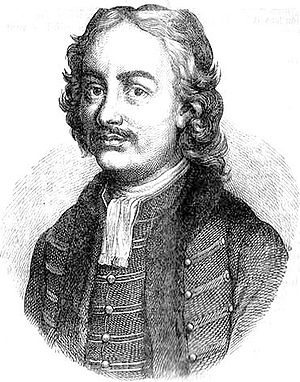
István Gyöngyösi
Encyclopedia

Hungary
Hungary , officially the Republic of Hungary , is a landlocked country in Central Europe. It is situated in the Carpathian Basin and is bordered by Slovakia to the north, Ukraine and Romania to the east, Serbia and Croatia to the south, Slovenia to the southwest and Austria to the west. The...
poet
Poet
A poet is a person who writes poetry. A poet's work can be literal, meaning that his work is derived from a specific event, or metaphorical, meaning that his work can take on many meanings and forms. Poets have existed since antiquity, in nearly all languages, and have produced works that vary...
, was born of poor but noble parents.
His abilities early attracted the notice of Count Ferenc Wesselényi
Ferenc Wesselényi
Count Ferenc Wesselényi de Hadad et Murány was a Hungarian military commander and the palatine of the Royal Hungary.-Life:...
, who in 1640 appointed him to a post of confidence in Fülek
Filakovo
Fiľakovo is a town in the Banská Bystrica Region of south-central Slovakia. Historically it was part of the Nógrád region.-Geography:...
castle. Here he remained till 1653, when he married and became an assessor of the judicial board. In 1681 he was elected as a representative of his county at the diet held at Sopron
Sopron
In 1910 Sopron had 33,932 inhabitants . Religions: 64.1% Roman Catholic, 27.8% Lutheran, 6.6% Jewish, 1.2% Calvinist, 0.3% other. In 2001 the city had 56,125 inhabitants...
(Ödenburg). From 1686 to 1693, and again from 1700 to his death in 1704, he was deputy lord-lieutenant of the county of Gömör.
He was the follower and competitor of the poet and warrior Miklós Zrínyi
Miklós Zrínyi
Miklós Zrínyi or Nikola Zrinski was a Croatian and Hungarian soldier, statesman and poet, member of the Zrinski noble family....
, the author of the Szigeti veszedelem, the greatest epic poem of that age. In contrast with Zrínyi's rough technique and concise performing, Gyöngyösi always wrote in mild and elaborated style with perfect rhymes, but had little sense for composition. During the 18th century, Gyöngyösi was the most popular author in Hungary; he was called the "Hungarian Ovid".
Of his literary works the most famous is the epic poem Murányi Venus (Kassa
Košice
Košice is a city in eastern Slovakia. It is situated on the river Hornád at the eastern reaches of the Slovak Ore Mountains, near the border with Hungary...
, 1664), in honour of his benefactor's wife Mária Szécsi, the heroine of Murany. Among his later productions the best known are Rózsa-Koszorú, or Rose-Wreath (1690), Porábúl meg-éledett Phoenix or Kemeny-Linos (1693), Csalárd Cupido (1695 - transcript from Ovid
Ovid
Publius Ovidius Naso , known as Ovid in the English-speaking world, was a Roman poet who is best known as the author of the three major collections of erotic poetry: Heroides, Amores, and Ars Amatoria...
's Metamorphoses), Palinodia (1695) and Chariklia (1700 - verse transcript of Heliodorus
Heliodorus
-People:Several persons named Heliodorus are known to us from ancient times, the best known of which are:*Heliodorus a minister of Seleucus IV Philopator ca...
' Aethiopica).
The earliest edition of his collected poetical works is by Dugonics (Pozsony and Pest, 1796); the first modern selection is that of Toldy, entitled Gyöngyösi István válogatott poétai munkái (Select poetical works of Stephen Gyongyosi, 2 vols, 1864–1865); the best and complete edition is that of Ferencz Badics, entitled Gyöngyösi István összes költeményei (Complete poetical works of Stephen Gyöngyösi, 4 vols, 1914–1937). New revised edition in separate volumes: Márssal társalkodó Murányi Venus (1998), Porábúl meg-éledett Phoenix (1999), Thököly Imre és Zrínyi Ilona házassága - Palinodia (2000), Rózsakoszorú (2002), Csalárd Cupido - Proserpina elragadtatása - Dédalus temploma - Heroida fordítások (2003), Chariclia (2005).
----

